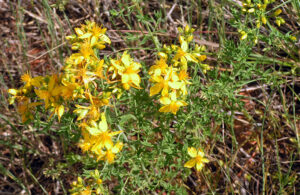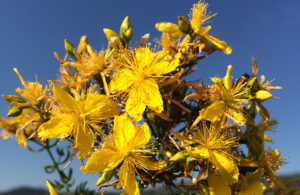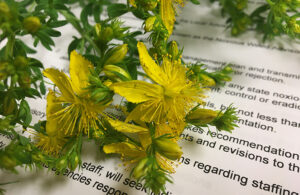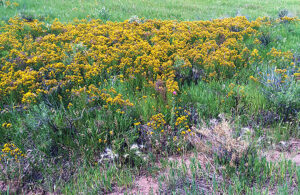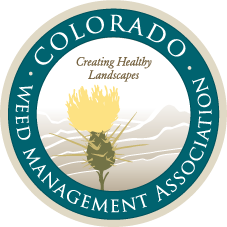Common St. Johnswort
Hypericum perforatum
A native of Europe, Common St. Johnswort was introduced to North America in the late 1600s as an ornamental and medicinal plant. It is a List C member of the Hypericaceaefamily. Also known as Klamathweed or goatweed. Our first record in Colorado is from 1834.
Plants are 1-3 feet tall but can reach up to 5 feet tall. They are a somewhat shrubby perennial herbaceous forb.
Multiple rust-colored stems grow from the woody root crown. Stems are woody below and herbaceous and branched above. Leaves are sessile (no petiole), entire, opposite, up to 1.2 inches long, and narrow. The leaves have distinct translucent pores and black dots along the leaf margins.
Flowers are bright yellow, about ¾ inch wide with numerous stamens. Flowers grow in clusters of up to 100 and are found at the end of the stems. The petal edges also have dark dots.
Reproduction is from seed and rhizomes. Each plant produces 15,000 to 34,000 seedsthat last anywhere from 3 to 50 years. The vertical roots grow to 5 feet deep and lateral roots (rhizomes) extend about 3 feet from the crown and sprout new plants.
Seeds can be spread by wind, water, and wildlife. They germinate in fall and summer.
Goats and deer will feed on Common St. Johnswort but most animals will avoid it. It contains chemicals that causes blistering and edema and causes light skinned animals to be sensitive to sunlight.
The chemicals found in Common St. Johnswort include hyperforin and hypericin. They show anti-depressant activity but both have been shown to interfere with other prescription medicines.
Common St Johnswort is found in grasslands and meadows, often as a result ofovergrazing.
There are 500 species of Hypericum worldwide. In Colorado our native Hypericum include Scouler’s St. Johnswort (Hypericum scouleri) and Large St. Johnswort (Hypericum majus).
Common St. Johnswort has been kept in check in many places by the biological controlagents Chrysolina quadrigemma and C. hyperici. These foliage feeding beetles were first released over 30 years ago and are well established in Colorado.
National Invasive Species Information Center
https://www.invasivespeciesinfo.gov/terrestrial/plants/st-johnswort
Status of Biological Control Agents Used for Managing Invasive Plants in Colorado
https://montezumacounty.org/wp-content/uploads/2020/10/BiologicalControlAgentsforInvasiveWeeds.pdf
Ohio Perennial and Biennial Weed Guide
